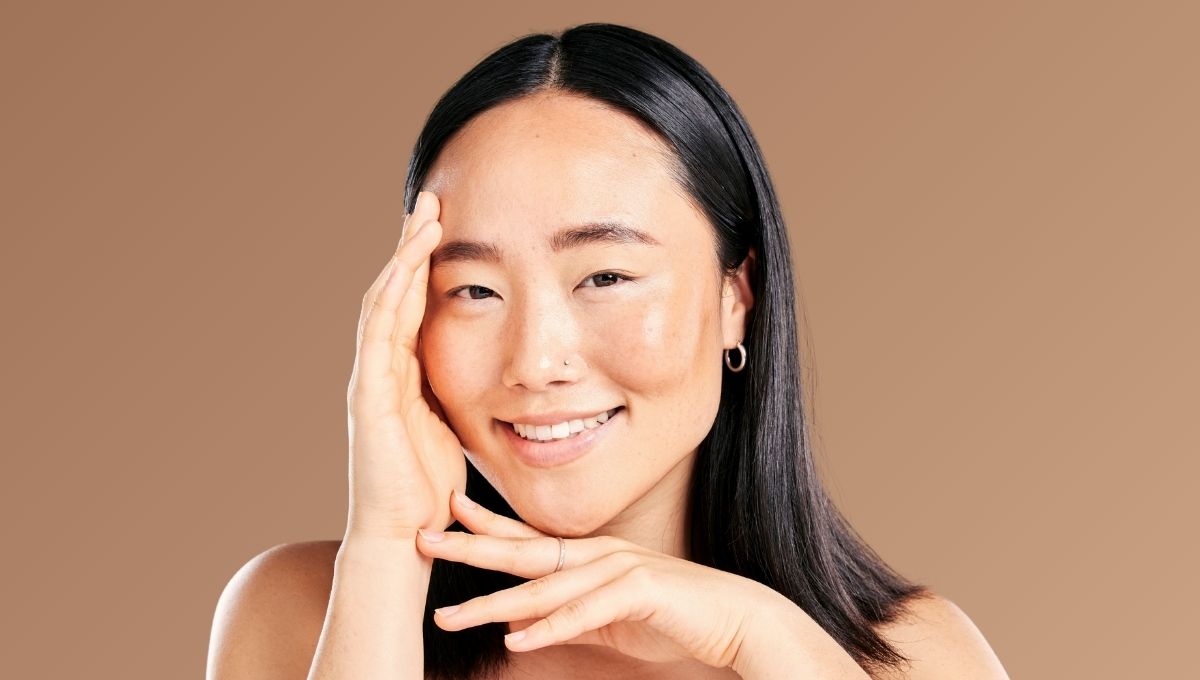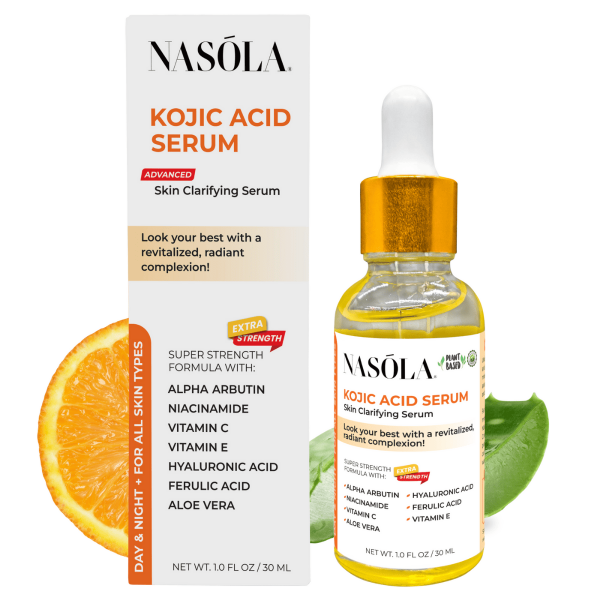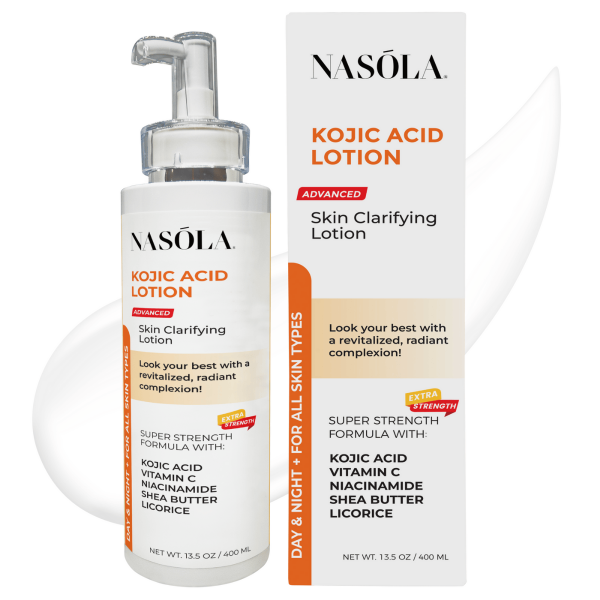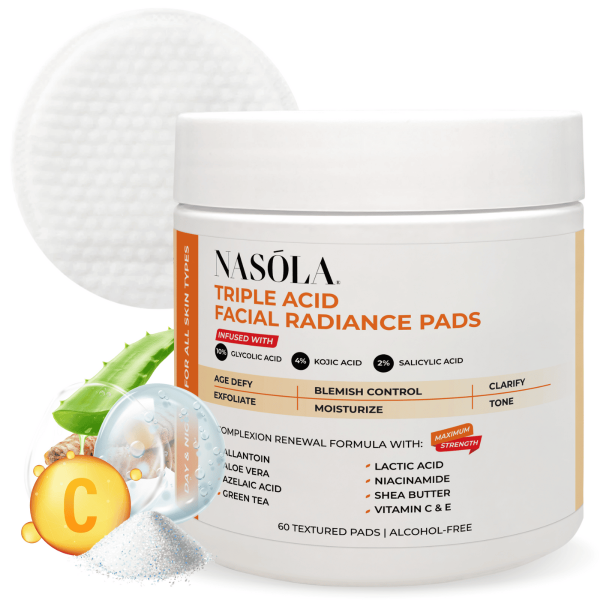Struggling with uneven patches, dark spots, or melasma that just won’t fade? You’re not the only one.
And while there are a thousand creams calling your name at the drugstore, finding the best pigmentation cream recommended by dermatologist is a whole different story.
Dermatologists prioritize ingredients backed by science—not hype—to give REAL results. And if you’re tired of wasting money on products that scream promises but deliver nada, stay with me.
Brands like Nasola are changing the game—calmly, confidently, and effectively. Their targeted treatments, including the Nasola Kojic Acid Cream and the Nasola Triple Acid Facial Radiance Pads, harness nature + science to fade spots and brighten skin without wrecking your barrier.
Sounds like a dream? It is. But it’s also real.
Let’s break it all down, shall we?
- What Makes the Best Pigmentation Cream Recommended by Dermatologist?
- Kojic Acid — The Star Ingredient in Dermatologist-Approved Creams
- Best Dermatologist-Recommended Products for Hyperpigmentation Treatment
- Additional Proven Ingredients Found in the Best Pigmentation Cream Recommended by Dermatologist
- How to Build a Skincare Routine with the Best Pigmentation Cream Recommended by Dermatologist
- Choosing the Right Dermatologist-Recommended Pigmentation Cream for Your Skin Type
- Spot-Treating vs. Full-Face Use: Best Practices with Dermatologist-Recommended Products
- Three Extra Tips to Maximize the Best Pigmentation Cream Recommended by Dermatologist
- Conclusion
- Frequently Asked Questions (FAQs)
What Makes the Best Pigmentation Cream Recommended by Dermatologist?
When dermatologists put their name behind a product, it means something. It’s about more than marketing—the best pigmentation cream recommended by dermatologist is safe, effective, and thoughtfully formulated.
These aren’t just for Instagram-worthy packaging. They’re for skin that demands measurable change.
That change starts with understanding your skin’s signals. If you’ve ever noticed pigment sticking around after a breakout or sun exposure, those might be signs of deeper issues your everyday moisturizer can’t correct.
Hyperpigmentation is complex and requires strategic ingredients, used consistently.
To properly judge what’s best, dermatologists look at:
- Ingredient integrity—are they supported by research and clinical results?
- Stability of formulation—will it oxidize or irritate with time?
- Tolerability—is it safe for sensitive, acne-prone, and melanin-rich skin?
- Compatibility—can it be layered with other actives or act as a stand-alone treatment?
Understanding Hyperpigmentation Types
Hyperpigmentation isn’t one-size-fits-all. There are specific categories, and recognizing yours helps target treatment more accurately with dermatologist-recommended solutions.
- Melasma: Often triggered by hormonal imbalances or pregnancy, it’s deep and hard to fade. Sunscreen is critical here.
- Post-Inflammatory Hyperpigmentation (PIH): Usually follows acne, insect bites, or skin trauma. Typically more superficial and responds well to topical actives.
- Sun Spots: Caused by long-term sun exposure. Usually show up in your 30s+ and are best tackled with both daily SPF and exfoliating agents.
Knowing which one you’re wrestling with helps you pick the best pigmentation cream recommended by dermatologist—and see faster results.
How Dermatologists Evaluate Pigmentation Creams
Now let’s talk checklist… because yes, dermatologists have one.
- Evidence-Based Ingredients — Hydroquinone, kojic acid, alpha arbutin, niacinamide, glycolic acid all pass the test.
- Non-Irritating Bases — Gels or creams that smooth on nicely and don’t clog pores.
- Visible Results — Creams should give a noticeable difference in dullness, tone, and clarity usually within 8–12 weeks.
- Derm-Tested and Approved — Ideally fragrance-free and safe for long-term use, especially for darker skin tones prone to PIH.
They’re not just grabbing at whatever’s trending. They’re applying decades of knowledge to your skincare cabinet.
Kojic Acid — The Star Ingredient in Dermatologist-Approved Creams
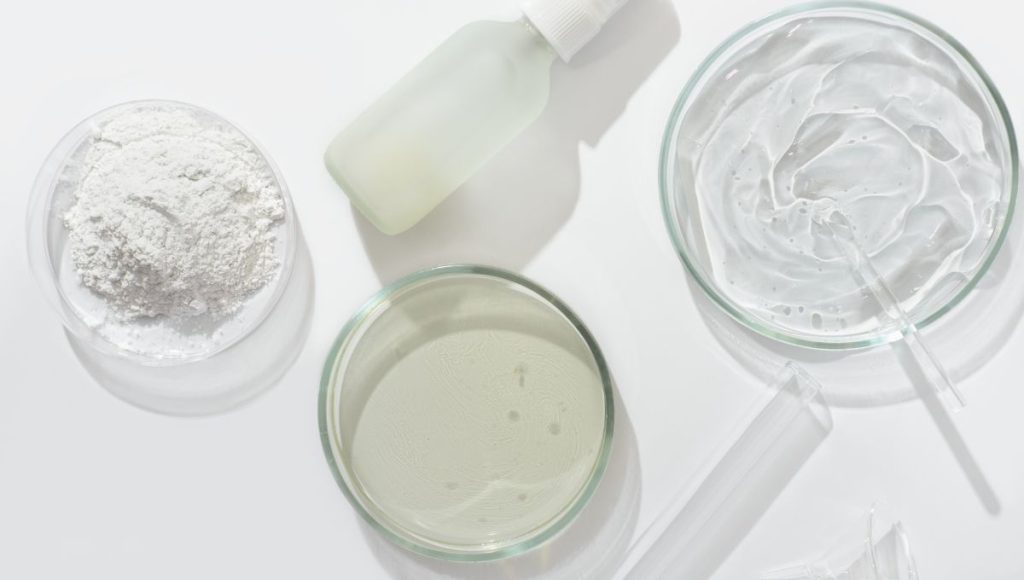
Ahhh kojic acid. If you’re into skin brightening and still haven’t heard of this powerhouse, where have you been??
It’s the ingredient behind some of the best pigmentation creams recommended by dermatologist, and for good reason.
Derived from fungi, kojic acid targets melanin production where it starts. By inhibiting the enzyme tyrosinase, it halts the overproduction of pigment.
Here’s the beauty of it—it offers potent results without the harsh downstream effects of hydroquinone.
What is Kojic Acid?
Kojic acid is a natural molecule born of fermentation—specifically from sake or rice wine production. Think of it as your skin’s personal detox, gently lifting the veil of hyperpigmentation with every use.
It mainly operates by reducing melanin synthesis. Translation? It nips discoloration in the bud by slowing pigment production at the source.
And unlike some fade-fast treatments, kojic acid typically goes easy on your skin, even with long-term use.
Safe, yet serious.
Why Kojic Acid is Recommended by Dermatologists
Ask any board-certified derm and you’ll hear it again: kojic acid is reliable.
Its popularity isn’t hype. It’s built on a strong reputation for:
- Being well-tolerated by all skin tones
- Pairing beautifully with vitamins, exfoliants, and hydrators
- Reducing dark patches without bleaching
- Acting as an antioxidant that soothes, not disrupts
Now pair that with a product that actually respects kojic acid’s magic…
Featured Product: Nasola Kojic Acid Cream
Say hello to your new best friend. The Nasola Kojic Acid Cream isn’t just hydrating—it’s a full-blown treatment plan wrapped in a silky, non-greasy base.
- Contains kojic acid to fade stubborn pigmentation.
- Includes moisturizers to combat dryness (a common irritation after introducing new actives).
- Gentle enough for daily use but tough on discoloration.
Just a pea-sized amount, consistently, and the glow train starts moving. Fast. ✨
Best Dermatologist-Recommended Products for Hyperpigmentation Treatment
So… what ARE the products dermatologists keep in their own cabinets? Simple—those that combine performance, gentleness, and versatility.
This is where Nasola comes in big. Their product lineup offers multiple entry points depending on skin type, routine complexity, and how aggressive or gentle you want to go.
Let’s talk about top contenders that beautifully match the blueprint for the best pigmentation cream recommended by dermatologist:
Nasola Kojic Acid Serum: Lightweight But Powerful
Prefer serums over creams? No worries—Nasola Kojic Acid Serum is your breakout solution.
- Ultra-lightweight; glides on and disappears.
- Rich in kojic acid + natural brighteners.
- Alcohol-free and paraben-free to avoid unnecessary irritation.
- Works incredibly well on oily or acne-prone skin without congestion.
You’ll love how fast it soaks in—and how calm your skin stays.
Nasola Triple Acid Facial Radiance Pads: Exfoliation Simplified
Yes, actives matter—but if they’re stuck under dead skin? They don’t work. That’s why exfoliation matters A LOT when you’re trying to fade spots.
- 3 acids (glycolic, lactic, salicylic) tag team dullness + texture.
- Aloe vera diffuses any post-use redness.
- Witch hazel tightens up those nicked, visible pores.
- Pre-soaked, biodegradable, and travel-friendly.
One pad. Two minutes. A noticeable upgrade in tone + clarity.
Nasola Kojic Acid Lotion: Full-Body Pigmentation Care
Hyperpigmentation doesn’t stop at the jawline—it shows up on your arms, legs, back. That’s where Nasola Kojic Acid Lotion absolutely delivers.
- Designed to treat larger patches of unevenness.
- Powered by kojic acid and glycerin.
- Lightweight hydration with serious brightening.
- Great for body skin that’s thicker and slower to respond.
Slip it into your post-shower routine and watch the months-old dark spots fade.
Additional Proven Ingredients Found in the Best Pigmentation Cream Recommended by Dermatologist
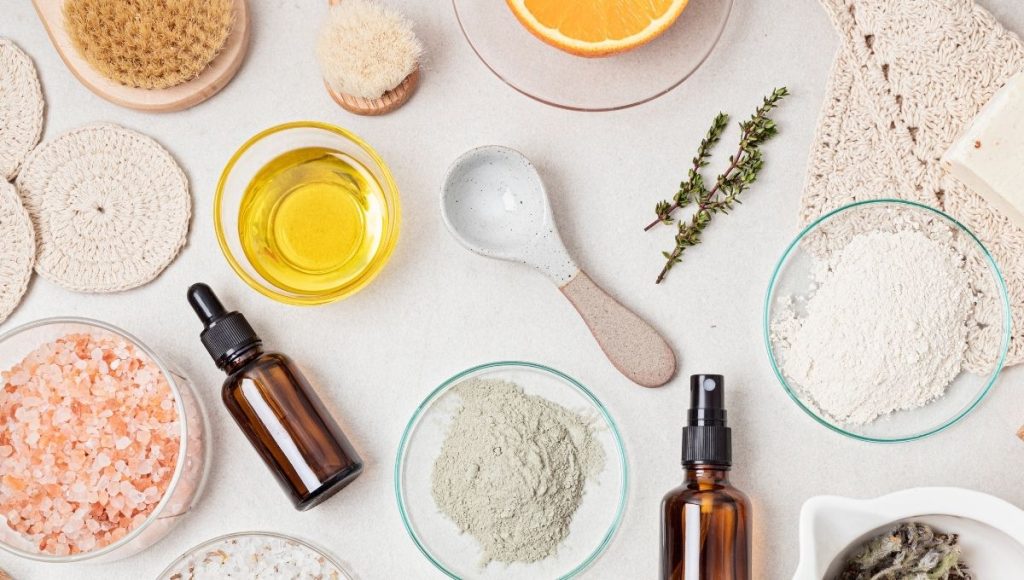
Now, if you wanted to go full-on ingredient geek (like me), here’s what ELSE you’ll find in the best pigmentation formulations backed by derms.
These are complementary power players that either boost kojic acid or tackle the pigmentation from different angles.
- Hyaluronic Acid: Keeps moisture levels up and minimizes irritation.
- Niacinamide: Calms inflammation while reinforcing your skin barrier.
- Glycolic Acid: Peels dead skin, revealing fresh glowy skin underneath.
- Vitamin C: Fights oxidative stress. Brightens without over-drying.
- Alpha Arbutin: A gentle tyrosinase inhibitor—similar to kojic acid but softer.
Basically, it’s skincare chemistry done RIGHT.
How to Build a Skincare Routine with the Best Pigmentation Cream Recommended by Dermatologist
Ready to put it all together in real life? Here’s how a derm would build you a routine using some of the top pigmentation products. And yes—consistency wins here.
Step-by-Step Routine Example Using Nasola Products
- Cleanser – Start fresh. Non-stripping, please.
- Nasola Kojic Acid Serum – After pat-drying, apply evenly across your face.
- Nasola Kojic Acid Cream – Locks it all in and continues the spot-fighting treatment.
- SPF – The non-negotiable step. Always.
Nighttime Routine Tips
- Add in Nasola Triple Acid Facial Radiance Pads 2-3 nights per week.
- Layer on a gentle retinol afterward, once your skin is comfortable with acids.
- Moisturize comprehensively. Pigmentation responds best to a healthy, reinforced barrier.
Choosing the Right Dermatologist-Recommended Pigmentation Cream for Your Skin Type
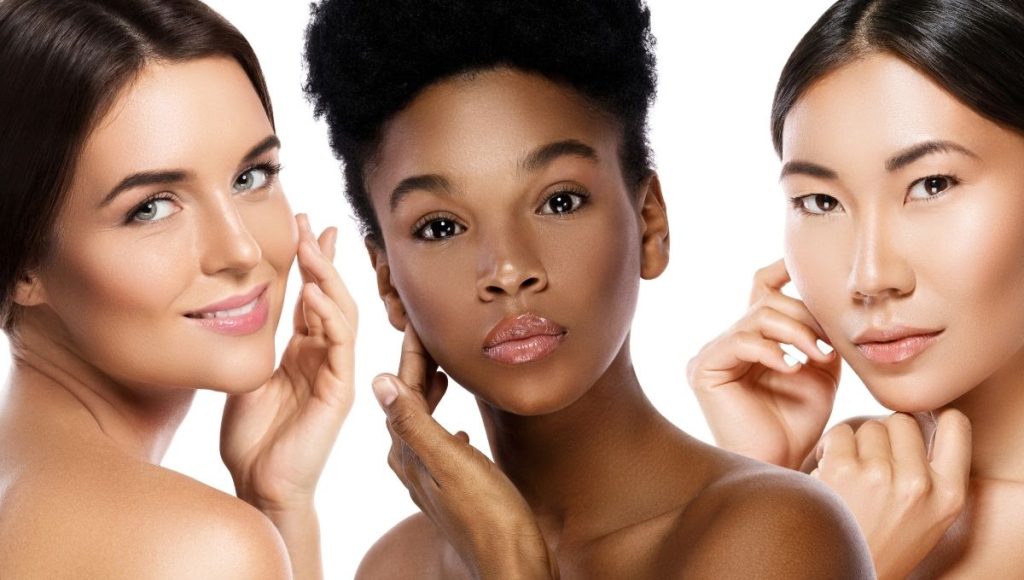
Not all pigmentation creams are created equal—not every formula stacks up for oily vs. dry skin. The best pigmentation cream recommended by dermatologist for YOU is the one that suits your skin’s unique rhythms.
Oily or Acne-Prone Skin
Go for:
- Serums with fast absorption (like the Nasola Kojic Acid Serum)
- Ingredients like niacinamide or witch hazel that calm excessive oil
- Lightweight hydrating gels that don’t suffocate pores
Dry or Sensitive Skin
What works better:
- Creamy formulas lock in moisture while correcting discoloration, like Nasola Kojic Acid Cream
- Bonus if it includes hyaluronic acid or ceramide precursors
- Avoid formulas with high alcohol content or excessive exfoliants
Your skin will love the extra TLC.
Spot-Treating vs. Full-Face Use: Best Practices with Dermatologist-Recommended Products
Let’s face it: sometimes the problem is everywhere, other times it’s just a tiny spot that ruins your whole mood. Here’s how to tackle both.
Spot Treatments
For PIH or acne scars:
- Use Nasola Kojic Acid Cream directly on dark marks at night.
- Follow with moisturizer to seal and protect.
Spot-targeting is great for minor breakouts and small discoloration areas.
Full-Face Application
When you’re dealing with diffuse melasma or sunspots:
- Go with a layered approach using both Nasola Kojic Acid Serum + Cream.
- Apply sparingly but evenly.
- Don’t forget your neck and décolletage!
Consistency and patience… that’s the name of the game.
Three Extra Tips to Maximize the Best Pigmentation Cream Recommended by Dermatologist

Be Patient but Persistent
Pigmentation didn’t show up overnight and—sorry—it won’t vanish in two days. But it WILL get better if you give it:
- The right actives
- A consistent regimen
- Some sunscreen loyalty ☀️
- Daily hydration support
Layer Ingredients Strategically
Two actives walking into a skin barrier? Could be a disaster—or a dream team. Combine smartly:
- Kojic acid + Vitamin C: Brightening duo
- Glycolic acid + Alpha Arbutin: Peel & fade combo
- Niacinamide + anything: The peacekeeper
Avoid Comedogenic or High-Fragrance Bases
Yes, even if it smells amazing. Fragrance isn’t doing your hyperpigmentation any favors. Look for:
- Fragrance-free or low-scent formulations
- Non-oily bases
- Sensitivity-tested options like Nasola offers
Conclusion
At the end of the day, choosing the best pigmentation cream recommended by dermatologist comes down to trusting what works—over trends or skincare fads.
Ingredients like kojic acid, niacinamide, and glycolic acid stand out for a reason: they work, safely, with time-tested consistency.
Nasola’s line of pigmentation-targeted products—Nasola Kojic Acid Cream, Serum, Lotion, and Triple Acid Pads—offers safe, proven options you can actually build a real routine around.
Your brighter, clearer skin? It’s not just a wish. It’s 100% within reach.
Commit to it. Your future face will thank you. 💫
Frequently Asked Questions (FAQs)
The Nasola Kojic Acid Cream is highly regarded by dermatologists due to its gentle yet effective kojic acid formula, suitable for daily use. It helps fade dark spots, melasma, and acne-induced pigmentation without causing dryness or irritation.
Yes, but choose formulations that are fragrance-free and specifically designed for sensitive complexions. Nasola Kojic Acid Cream is a gentle choice, packed with hydrating ingredients to support barrier health while reducing discoloration.
Most dermatologist-recommended creams show visible improvements in 4 to 12 weeks if used consistently with SPF. Results also depend on severity of pigmentation, your skin type, and adherence to a full routine.
You can! Introduce retinol separately and slowly. Use your pigmentation cream in the morning and retinol at night. For example, Nasola Triple Acid Radiance Pads at night and Kojic Acid Cream in the AM.
It depends on your skin type. If you’re oily, choose the Nasola Kojic Acid Serum. If your skin is dry or combination, the Nasola Kojic Acid Cream offers hydration and treatment in one product. Both can be layered for powerful results.
Some products with ingredients like glycolic or lactic acid can cause light peeling. Nasola Triple Acid Facial Radiance Pads are perfect for controlled exfoliation without irritation. Always pair actives with moisturizers.
Yes, kojic acid is generally safe for daily, long-term use when formulated at proper concentrations like in Nasola Kojic Acid Cream. Patch testing before routine use is always recommended.
Dermatologists recommend tapering to a maintenance routine. Continue a few times per week with actives like kojic acid, and always use sunscreen to prevent recurrence.
Pigmentation creams work on discoloration—not deep tissue scars. For acne-related dark spots (PIH), products like Nasola Kojic Acid Cream are perfect. Combine with AHA exfoliation from Triple Acid Radiance Pads if needed.
YES! It’s absolutely necessary. Active ingredients increase UV sensitivity. Without sunscreen, your dark spots may worsen. SPF 30+ daily is non-negotiable while using treatments like Nasola’s Kojic Acid Cream.

